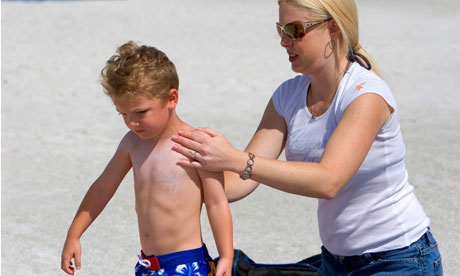
Splashing out on sun cream may not be the first thing on your mind this summer. And, according to a survey of 2,000 people carried out by Superdrug, that appears to stay true for many British people even when they go on holiday. Five out of 10 people admitted to burning on day one of their holiday. By day four, hardly anyone (no exact numbers were given) was applying sun cream. A survey spokesperson said that even during this dismal British summer, we should be using cream whenever the sun comes out. Superdrug might have a vested interest in people purchasing sun creams, but should we be following their advice regardless?
The solution
There are two types of ultraviolet rays that reach our skins. UVA causes ageing and UVB makes you burn. And both contribute to skin cancer. UVA goes through skin to damage collagen and make your skin leathery and wrinkled (you don't feel its effects at the time). UVB has a shorter wavelength and makes you look like a lobster. You need to buy sun cream that blocks both. Dermatologists advise that we wear it even on cloudy summer days as 80% of UV rays still reach the earth. This does depend on how thick the cloud is, however.
The UV index is an international measure of the intensity of rays. Measurements of more than three can cause skin damage. Recent UV indexes, even with the relentless rain, have been between two and six in Britain. The temperature is not an indicator for when you need sun cream. It can be cold outside, (e.g. if you go skiing) but if the sun is shining brightly in a cloudless sky, there is a risk of burning.
Sun cream lasts two to three years – don't use it after its sell by date. You should apply sun cream 20 minutes before you go outside as it takes time to work. The sun protection factor (SPF) indicates how long a cream lets you stay in the sun without burning. So if it would normally take 10 minutes for you to burn, then an SPF of 15 would in theory let you stay out for 150 minutes. No sun cream is really waterproof against a lengthy stint in a pool so you should reapply when you get out, and on a two hourly basis, regardless of the SPF. You need about an ounce to cover your body – the size of a small shot glass – and don't rub it in too thoroughly. Don't forget to cover your ears, backs of knees, and legs and shoulders. And expensive does not necessarily mean better.
Ultimately, sun creams cannot completely protect you – they all allow some UV rays through. If you get a tan, it's less a sign of health, and more an indicator that you've damaged your skin. When in the Mediterranean, behave like a native and have a midday siesta in the shade instead.

